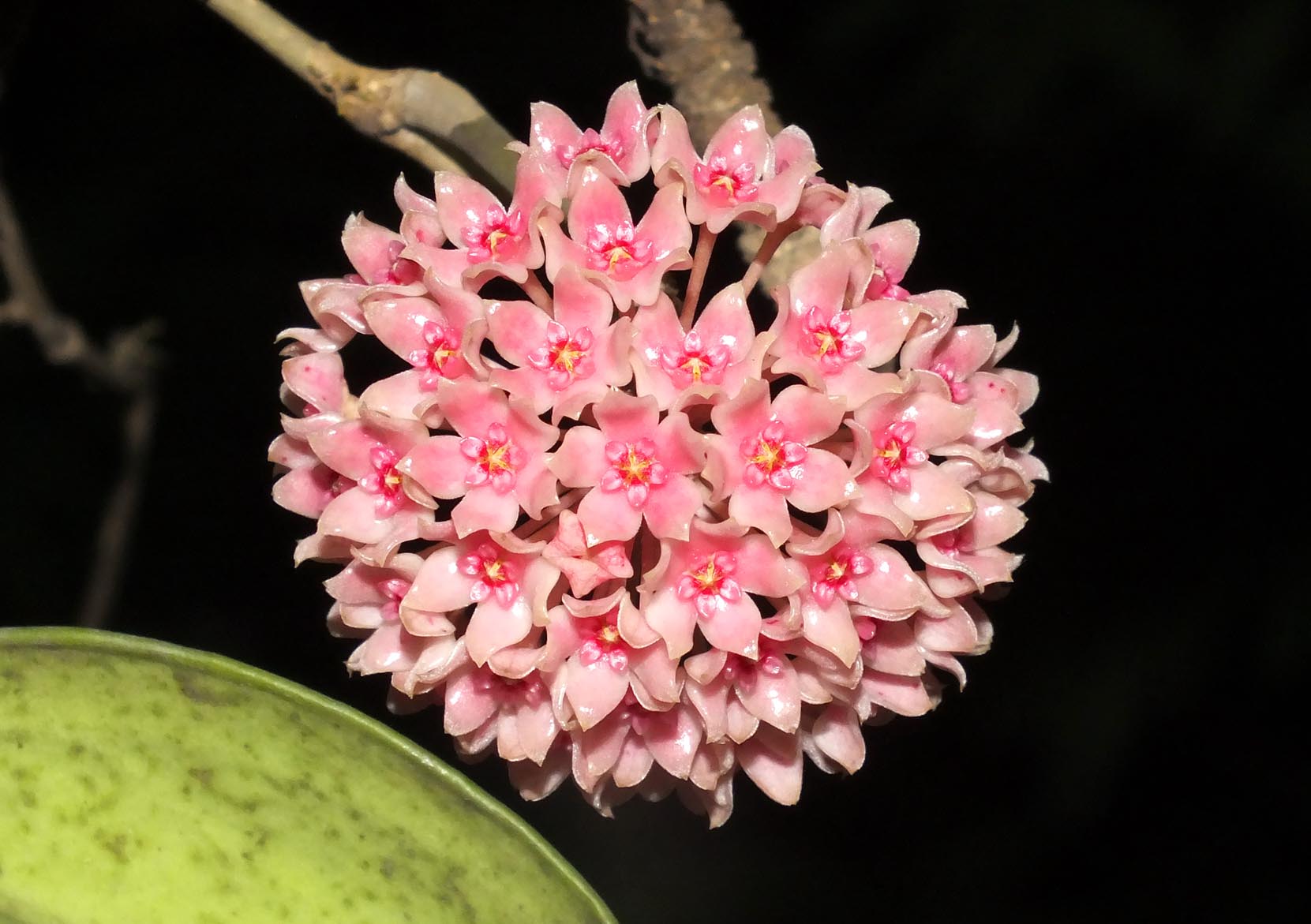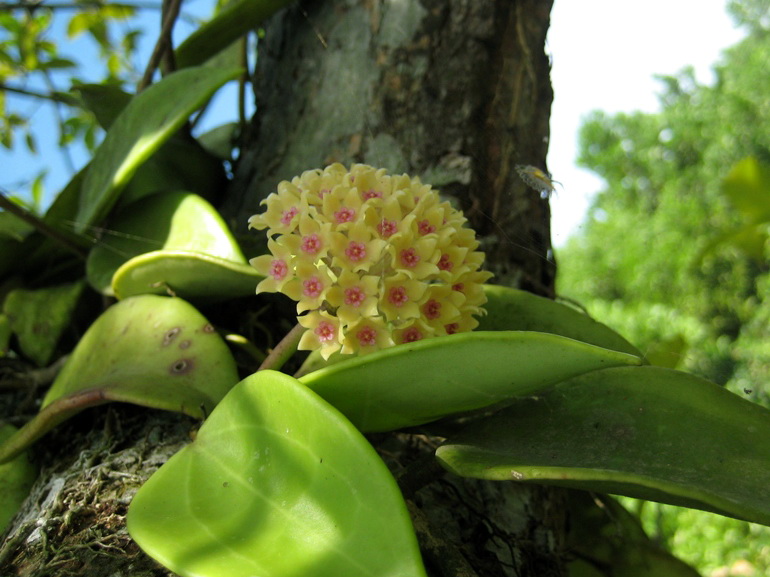A new species Hoya hanhiae (Apocynaceae, Asclepiadoideae) from Central Vietnam - Phát hiện loài Cẩm cù hạnh Hoya hanhiae mới cho khoa học
PHÁT HIỆN LOÀI CẨM CÙ HẠNH MỚI CHO KHOA HỌC [Xem>>]
Hoya R. Br. (Apocynaceae, Asclepiadoideae) consists of over 200 species that occur in tropical South-East Asia, tropical islands of Pacific Ocean, and Queensland. Of which, twenty four species were reported from Vietnam up to now. During recent field trip, another specimen of Hoya was found in Quang Tri and Khanh Hoa provinces, central Vietnam. After studies of collections stored in Vietnamese Herbaria (HN, HNU, HNIP, VNM) and Herbaria of Komarov Botanical Institute (LE), we propose description of our plant as a new species for science.

Fig. 1 Pink coloration of Hoya hanhiae. Photo by Nguyen Thuy Hanh
Hoya hanhiae V. T. Pham et Aver., sp. nov. Epiphytic semiwoody vine with white latex. Young stems, petioles and peduncles pubescent, glabrous when old. Stems twisted, 3–5 m long, rooting at nodes and internodes, green when young, turning brown green, white-gray when old, terete, 2.5–4 mm in diam., with swollen nodes, internodes to 12 cm long. Leaves decussate, fleshy; petiole twisted, hairy when young, 1.5–3.5(5) cm long, 3–4(6) mm in diam., terete, dark green with dirty purple marks; leaf blade ovate to broadly ovate, glabrous, 6–17 cm long, 4–10 cm wide, rounded to cuneate at the base, shortly acuminate at apex, with entire, slightly revolute margin, 3–5 veined from the base with the 2 veins nearest the magins usually indistinct, visible adaxially, obscure abaxially; secondary veinlets anastomosing-reticulate, glossy green adaxially, dull white-grey, uneven abaxially, with concave veins in old marcescent leaves. Inflorescences extra-axillary, semi-globose, many flowered umbel-like; peduncle terete, 2.5–9 cm long, 2–4 mm in diam., swollen at apex, green to dull green. Flowers 25–43, pedicels light yellow to pink, tinged with purple, slender, glabrous, 1.5 cm long, about 0.75 mm in diam.; calyx of 5 sepals, light yellow or light pink, sometimes tinged with dirty purple, triangular, acute, glabrous, about 1.5 mm long, 1 mm wide; corolla 5-lobed, fleshy, pale yellow to pink-purple, about 1 cm in diam.; lobes broadly ovate, outside glabrous with obscure veins, inside pubescent, about 4 mm long, 3 mm wide, spreading; apex subacute, margins slightly recurved; corona of 5 segments, 3–3.5 mm in diam., concave at center; corona segments more or less erect, pink to pink-purple, glossy, grooved outside, 1.8–2 mm tall, 0.9–1.1 mm wide, oblong from side view, ovate from above, outer angle subacute, light pink, inner angle acute, red-pink; pollinarium with two oblong, golden-yellow, pollinia about 0.6 mm long, 0.2 mm wide, corpusculum chestnut, about 0.15 mm long and wide; ovaries 2, free, superior, light green, bottle shaped, about 1.2–1.5 mm tall, 0.9–1.1 mm wide. Follicles narrowly-ensiform, about 10 cm long, 0.6–0.8 cm in diam., light green with many dirty purple marks. Seeds many, spindle shaped, about 6 mm long, 1 mm wide, apically with white silky coma, 3 cm long.

Fig. 2 Hoya hanhiae sp. nov. (a) flowering plant in natural habitat, (b) eaves, (c) inflorecscences with flowers of various coloration, (d) inflorescence, view from below, (e)flowers, frontal and half-side views, (f) flowers and their parts, (g) fruits, (h) seeds.Photographs by Le Tuan Anhand Nguyen Thuy Hanh, design and image correction by L.Averyanov.
Etymology: The species is named after plant discoverer Mrs. Nguyen Thuy Hanh.
Distribution: Lowland coastal areas of Quang Tri (Hai Lang distr.) and Khanh Hoa (vicinities of Nha Trang city) provinces in central Vietnam.
Ecology: This species was observed as an epiphytic creeping vine on large old trees in secondary tropical evergreen seasonal broad-leaved lowland swamp forest on sandy soil at elevation 10-50 m a.s.l., near sea shore. As dominants trees and shrubs in habitats of H. hanhiae were observed Uvaria cordata, Cereus repandus, Tetracera sarmentosa, Barringtonia acutangula, Sterculia lanceolata, Salacia wrightii, Syzygium bullockii, Memecylon umbellatum, Carallia brachiata, Gluta wrayi, Acronychia pedunculata, Fagraea fragrans, Garcinia sp., Lithocarpus sp.
Phenology: Flowering was sporadically observed from June to August. Flowers open at late afternoon and close to next day morning, caducous in 3-4 days. Fruits were seen in August.
Similar species: Hoya hanhiae is similar to H. macrophylla Bl. and H. verticillata (Vahl) G. Don which could be found in Vietnam but can be distinguished morphologically as summarized in Table bellow.
| Characters | H. hanhiae | H. macrophylla | H. verticillata |
| Leave blade (cm) | 6–17 X 4–10 | 4.5–18 X 2.5–8.8 | 7–14 X 3.5–6.5 |
| Petiole (cm) | 1.5–3.5(5) | 1.5–3 | 0.5–2.5 |
| Primary vein | visible above, obscure below | distinct on both sides | obscure on both sides |
| Inflorescence | extra-axillary | Axillary | extra-axillary |
| Peduncle (cm) | 2.5–9 | 2–5 | 3-7 |
| Pedicel (cm) | 1.5 | 1-2 | 2.5-3 |
| Flower color | light pale yellow or pink-purple | white tinged with pink at tip of lobes | white |
| Calyx segment tip | acute | acute | obtuse |
| Corolla diam. (cm) | 1 | 1.8 | 1.5 |
| Corolla diam. (cm) | inside pubescent | inside pubescent | inside glabrous or weakly pubescent |
| broadly ovate, subacute | ovate, acute | ovate, acute | |
| Corona lobe | subacute | triangular | lanceolate |

Fig. 3.Yellow coloration of Hoya hanhiae. Photo by Tran Thi Thu Hien
The article was accepted by Nordic Journal of Botany (http://www.nordicjbotany.org/accepted-article/hoya-hanhiae-sp-nov-apocynaceae-asclepiadoideae-central-vietnam) (The definitive version is available at www.blackwell-synergy.com).
Posted by CeREC. Writen by Pham Van The
CẨM CÙ HẠNH (Hoya hanhiae) LOÀI THỰC VẬT MỚI PHÁT HIỆN CHO KHOA HỌC Ở MIỀN TRUNG VIỆT NAM
Các nhà thực vật Việt Nam và Nga, trong đó có một thành viên của CeREC vừa phát hiện và mô tả một loài thực vật mới cho khoa học thuộc phân họ Thiên lý (Asclepiadoideae), họ Trúc Đào (Apocynaceae) với tên gọi Cẩm cù hạnh (Hoya hanhiae). Công bố này đã nâng tổng số các loài Cẩm cù của Việt Nam mọc tự nhiên lên 25 loài.

Ảnh 1. Dạng hoa màu hồng của Cẩm cù hạnh Hoya hanhiae. Hình chụp bởi Nguyễn Thuý Hạnh
Cẩm cù hạnh là loài sống phụ sinh trên các thân cây già, dạng dây leo nửa hoá gỗ. Chúng có các rễ bám mọc ra từ các đốt thân, và có thể dài đến 5 m. Lá mọc đối chữ thập, phiến lá nạc, hình trứng đến hình trứng rộng, phiến lá dài 6–17 cm, rộng 4–10 cm và nhẵn. Gốc lá hình nêm hoặc tròn, đầu lá nhọn. Lá có 3–5 gốc, trong đó 2 gân gần sát gốc thường không nhìn thấy.Các gân bên nhìn rõ ở mặt trên trong khi chúng mờ ở mặt dưới. Cụm hoa xuất hiện ngoài nách lá, có dạng nửa hình cầu, dạng hoa tán và mang nhiều hoa, chừng 25 đến 43 bông. Hoa có nhiều dạng màu sắc, nhưng màu phổ biến nhất là màu hồng và vàng. Quả nang dài chừng 10 cm và mang nhiều hạt, hạt có túm lông.

Ảnh 2. Cẩm cù hạnh Hoya hanhiae sp. nov. (a) cây mang hoa trong môi trường sống tự nhiên, (b) lá, (c) cụm mang hoa với nhiều dạng màu sắc, (d) cụm hoa nhìn từ phía sau, (e) hoa nhìn từ phía trước và nghiêng, (f) hoa và các phần của hoa, (g) quả, (h) hạt. Hình chụp bởi Lê Tuấn Anh và Nguyễn Thuý Hạnh, thiết kế bởi Leonid Averyanov.
Hoya hanhiae có đặc điểm hình thái lá khá giống với các loài H. macrophylla và H. verticillata do chúng có 3-5 gân gốc và đều có khả năng tìm thấy ở Việt Nam. Tuy nhiên chúng dễ dàng phân biệt bởi các đặc điểm so sánh trong bảng dưới đây.
| Đặc điểm | H. hanhiae | H. macrophylla | H. verticillata |
| Phiến lá (cm) | 6–17 X 4–10 | 4,5–18 X 2,5–8,8 | 7–14 X 3,5–6,5 |
| Cuống lá (cm) | 1,5–3,5(5) | 1,5–3 | 0,5–2,5 |
| Gân phụ | Rõ mặt trên, mờ mặt dưới | Rõ cả hai mặt | Mờ cả hai mặt |
| Cụm hoa | Ngoài nách lá | Nách lá | Ngoài nách lá |
| Cuống cụm hoa (cm) | 2,5-9 | 2-5 | 3-7 |
| Cuống hoa (cm) | 1,5 | 1-2 | 2,5-3 |
| Màu sắc hoa | Vàng hoặc hồng | Trắng với các chấm hồng ở đỉnh của cánh hoa | Trắng |
| Đầu lá đài | Nhọn | Nhọn | Tù |
| Đường kính hoa (cm) | 1 | 1,8 | 1,5 |
| Cánh hoa | Mặt trong đầy lông | Mặt trong đầy lông | Mặt trong nhẵn hoặc có ít lông |
| Hình trứng rộng, gần nhọn | Hình trứng, nhọn | Hình trứng, nhọn | |
| Thuỳ tràng phụ | Gần nhọn | Tam giác | Nhọn giáo |
Cẩm cù hạnh phân bố trong rừng thứ sinh cây lá rộng thường xanh mưa mùa nhiệt đới ở đất thấp trên đất cát tại các khu vực gần biển ở Quảng Trị và Nha Trang. Mùa hoa của chúng được quan sát vào mùa hè từ tháng 6 đến tháng 8 Dương lịch. Hoa rất thơm và có thể tồn tại đến 4 ngày, chúng có đặc điểm lạ là vào ban đêm thì hoa đóng lại sau đó lại mở ra vào sáng hôm sau.
Hoya hanhiae được đặt tên để kỷ niệm chị Nguyễn Thuý Hạnh, người đã có công phát hiện, thu mẫu và gửi các hình ảnh đẹp đến các nhà khoa học nghiên cứu. Ngoài hai màu phổ biến là hồng và vàng, một số khác được quan sát thấy màu vàng nhạt hoặc màu hồng thẫm. Đây là một loài Cẩm cù rất đẹp với sự đa dạng về màu sắc và là đặc hữu củaViệt Nam.

Ảnh 3. Dạng hoa màu vàng sáng của Cẩm cù hạnh Hoya hanhiae. Hình chụp bởi Trần Thị Thu Hiền
Công bố này hiện nay đã được chấp nhận và đang trong quá trình in bởi tạp chí Nordic Journal of Botany (http://www.nordicjbotany.org/accepted-article/hoya-hanhiae-sp-nov-apocynaceae-asclepiadoideae-central-vietnam) (Phiên bản cuối cùng có thể tìm thấy tại www.blackwell-synergy.com)
Xuất bản bởi CeREC. Tác giả: Phạm Văn Thế
Search
Main menu
- CeREC News - Bản tin CeREC
- Conservation Programs - Các chương trình bảo tồn
- Biodiversity Projects - Các dự án Đa dạng sinh học
- Environmental Projects - Các dự án Môi trường
- Training & Education - Đào tạo và Tập huấn
- Flagship Species - Loài trọng tâm của CeREC
- New Species- Loài mới phát hiện
- Law Enforcement - Thực thi pháp luật
- Publications - Các tài liệu xuất bản
- Technical Reports - Các báo cáo kỹ thuật
- Training Documents - Tài liệu đào tạo và Tập huấn
- Photo Reports - Phóng sự ảnh
- Nature Tours - Tham quan dã ngoại
- Partners & Donors - Đối tác và Nhà tài trợ
Recent Posts
Partners & Donors
CeREC thanks the following organizations for their generous support and sponsorship:





.jpg)


.jpg)

.jpg)


.jpg)
.jpg)
.jpg)




